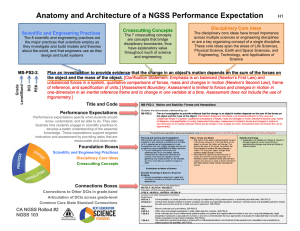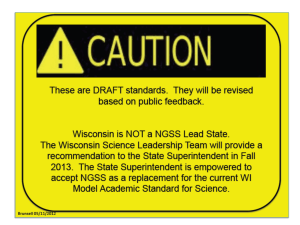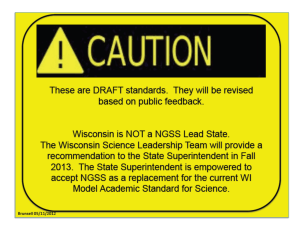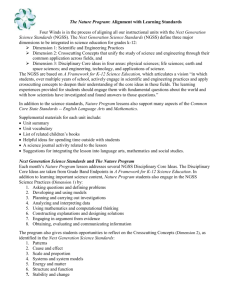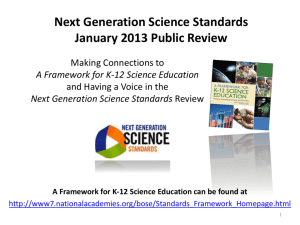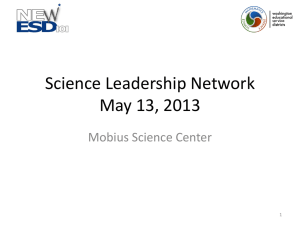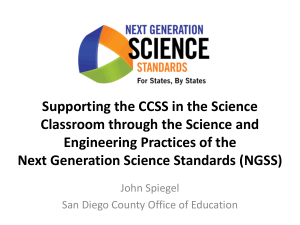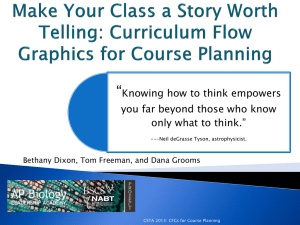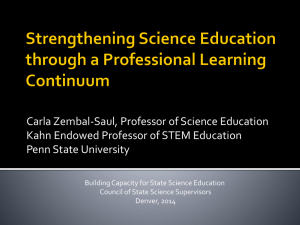States Adopting Next Generation Science Standards
advertisement
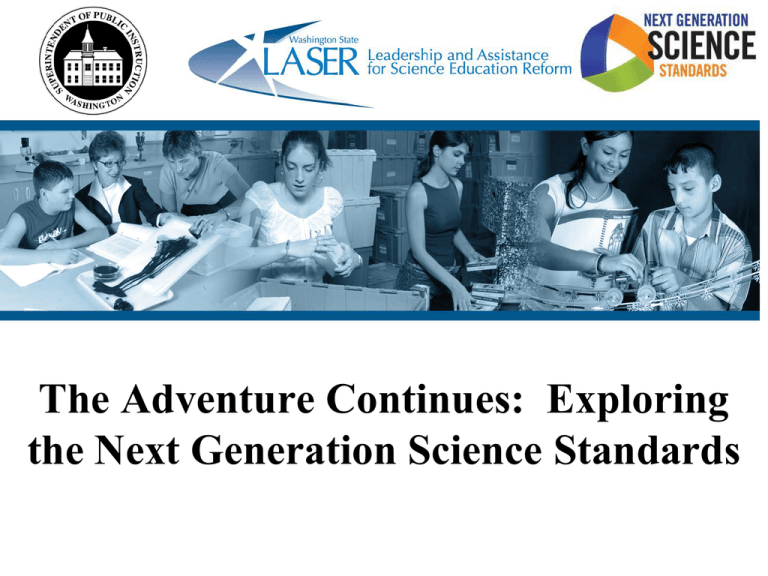
The Adventure Continues: Exploring the Next Generation Science Standards Jacob Clark Blickenstaff Program Director, Washington State LASER Ellen Ebert Science Director, OSPI Here today through generous support from Boeing Session Goals • Increase awareness of A Framework for K-12 Science Education and how this document connects to STEM education and informs the Next Generation Science Standards through a first-hand learning experience.. • Plan next steps as related to the Framework and Next Generation Science Standards. • Reflect on your role in the adoption and implementation of Next Generation Science Standards. Principles of A Framework for K-12 Science Education •Children are born investigators •Understanding builds over time •Science and Engineering require both knowledge and practice •Connecting to students’ interests and experiences is essential •Instruction focuses on core ideas and practices •Science learning standards promote equity 4 Framework Organization Dimensions of the Framework – Scientific and Engineering Practices – Crosscutting Concepts – Disciplinary Core Ideas Realizing the Vision – Integrating the Three Dimensions – Implementation – Equity and Diversity – Guidance for Standards Development – Looking Toward the Future: Research to Inform K-12 Science Education Standards Eight Practices – Asking questions and defining problems – Developing and using models – Planning and carrying out investigations – Analyzing and interpreting data – Using mathematics and computational thinking – Constructing Explanations and Designing Solutions – Engaging in argument from evidence – Obtaining, evaluating, and communicating information Seven Crosscutting Concepts o Patterns o Cause and effect o Scale, proportion, and quantity o Systems and system models o Energy and matter: Flows, cycles, and conservation o Structure and function o Stability and change • Four Disciplinary Core Ideas: Life Science, Physical Science Earth and Space Science Engineering 6 Science & Engineering Practices Learning Conceptualized along Three Dimensions --- Cross Cutting Concepts Leading to New Educational Standards Disciplinary Core Ideas Standards are taking the form of performance expectations defined through combinations of elements of the three dimensions that progress across grade levels NGSS “Lead” States (2011-present) WA is a lead state partner 2 writers >1000 reviewers during Public Draft Release 8 Kindergarten NGSS Earth Science Example 9 Middle School Earth Science Example 10 High School Earth Science Example 11 Performance Expectation MS-PS2 Motion and Stability: Forces and Interactions Students who demonstrate understanding can: MS-PS2-4. Construct and present arguments using evidence to support the claim that gravitational interactions are attractive and depend on the masses of interacting objects. [Clarification Statement: Examples of evidence for arguments could include data generated from simulations or digital tools; and charts displaying mass, strength of interaction, distance from the Sun, and orbital periods of objects within the solar system.] [Assessment Boundary: Assessment does not include Newton’s Law of Gravitation or Kepler’s Laws.] The performance expectations above were developed using the following elements from the NRC document A Framework for K-12 Science Education: Foundation Boxes Science and Engineering Practices Engaging in Argument from Evidence Engaging in argument from evidence in 6–8 builds from K–5 experiences and progresses to constructing a convincing argument that supports or refutes claims for either explanations or solutions about the natural and designed world. § Construct, use, and present oral and written arguments supported by empirical evidence and scientific reasoning to support or refute an explanation for a phenomenon or a solution to a problem. (MS-PS2-4) Disciplinary Core Ideas PS2.B: Types of Interactions § Gravitational forces are always attractive. There is a gravitational force between any two masses, but it is very small except when one or both of the objects have large mass—e.g., Earth and the sun. (MS-PS2-4) Crosscutting Concepts Systems and System Models o Models can be used to represent systems and their interactions—such as inputs, processes and outputs—and energy, matter, and information flows within systems. (MS-PS2-4) ------------------------------------------------------ Connections to Nature of Science Scientific Knowledge is Based on Empirical Evidence § Science knowledge is based upon logical and conceptual connections between evidence and explanations. (MSPS2-4) Connections to other topics in this grade-band: MS.ESS1.1 (MS-PS2-4); MS.ESS1.1 (MS-PS2-4); MS.ESS2.3 (MS-PS2-4) Articulation across grade-levels: 5.PS2.2 (MS-PS2-4); HS.PS2.2, (MS-PS2-4); HS.ESS1.2 (MS-PS2-4) Common Core State Standards Connections: ELA/Literacy – RST.6.3 Follow precisely a multistep procedure when carrying out experiments, taking measurements, or performing technical tasks. (MS-PS2-d) Mathematics – MP.2 MP.6 Reason abstractly and quantitatively. (MS-PS2-4) Attend to precision. (MS-PS2-4) Connection Boxes States Adopting Next Generation Science Standards As of October 4, 2013 No action yet States that have adopted standards WA Science Standards “Evolution” Washington Science Standards (2009) Next Generation Science Standards (2013) • Four Essential Academic Learning Requirements (EALRS) – Systems – Inquiry – Application – Domains • Life Science • Physical Science • Earth and Space Science • 14 • • Science and Engineering Practices – Identifies 8 Practices • Subsumes WA Inquiry Disciplinary Core Ideas – Adds Engineering and Technology • Subsumes WA Application Crosscutting Concepts – Adds 7 crosscutting concepts • Subsumes WA Systems and Application Findings 6/23/2013 • The vast majority of Washington science standards are fundamentally incorporated into the NGSS. OSPI Teaching and Learning Science • There is some movement of disciplinary core ideas between grades at the elementary level, but this realignment goes hand in hand with the goal of not getting ahead of the CCSS-M and CCSS-ELA standards. • In particular, the Systems, Inquiry and Application standards from Washington’s current standards are well-covered in the NGSS. • Modest differences exist between the Disciplinary Core Ideas in the NGSS and the Domain standards in Washington’s EALR 4. – Most of the difference involves re-sequencing and an emphasis on current scientific applications, but there is also a fundamental shift to a deeper focus on fewer topics, much like the CCSS. 15 NGSS – The 3 Shifts Focus: The NGSS are Focused on deeper understanding and application of science content reflecting real-world interconnectedness. Coherence: Science and engineering Build Coherently across K–12. Integration: Science and Engineering are Integrated across K–12 in the NGSS. 16 Federal Assessment Requirements • No Child Left Behind (NCLB) requires that our state’s science standards must be assessed: – Once in elementary school (we give Measurements of Student Progress in 5th grade) – Once in middle school (we give MSP in 8th grade) – Once in high school (we give Biology End-of-Course exam) • When we change our state standards in science we need to change assessments (RCW 28A.655.070). 17 WA State Science Assessment Evolution Original State Science Standards (2006) WASL comprehensive science test in grades 5, 8, 10 (2006) Assessment design changes Measurements of Student Progress in grades 5 & 8; High School Proficiency Exam in grade 10 (2010) New State Science Standards (2009) Measurements of Student Progress in grades 5 & 8 (2011); Biology End of Course exam in HS, usually grade 9 or 10 (2012) Next Generation Science Standards (2013) Once in elementary; once in middle; once in HS; exit exam? (2017?) 18 Transitioning – The 9144m View 2013-14 2014-15 2015-16 2016-17 Awareness of NGSS & integrated nature of dimensions Phase in standards Examine materials Continue phasing in standards Finish phasing in standards Ongoing: Statewide Coordination and Collaboration to Support Implementation (Professional Learning Providers and Partners Across WA ) Washington Including: • School Districts • Higher Education • Non-formal education groups • Education and Educator Associations • Business Partners Paired Verbal Fluency Find a person that you do not know: Introduce yourselves. Decide who is A and who is B. Person A listens to person B respond to the prompt until time is called (1 minute) Person B listens to person A respond to the topic until time is called (1 minute) Repeat the process as directed (30 seconds)) What might the adoption of Next Generation Science Standards mean for you in your context? What would a learning experience be like that integrates engineering, science, technology, and math? Eight Practices – Asking questions and defining problems – Developing and using models – Planning and carrying out investigations – Analyzing and interpreting data – Using mathematics and computational thinking – Constructing Explanations and Designing Solutions – Engaging in argument from evidence – Obtaining, evaluating, and communicating information Seven Crosscutting Concepts o Patterns o Cause and effect o Scale, proportion, and quantity o Systems and system models o Energy and matter: Flows, cycles, and conservation o Structure and function o Stability and change • Four Disciplinary Core Ideas: Life Science, Physical Science Earth and Space Science Engineering 25 Engineering Design Process Next Steps Today I learned… My next steps are…
